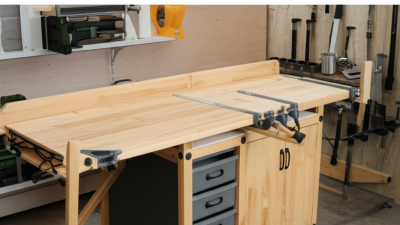How to Choose the Best Tool Workbench for Your DIY Projects
When embarking on DIY projects, having the right tool workbench is essential for achieving both efficiency and precision. According to a report by the Home Improvement Research Institute, nearly 65% of DIY enthusiasts attribute their project's success to having adequate workspace equipped with high-quality tools. A well-chosen tool workbench not only provides the necessary surface area for various tasks but also enhances organization, helping hobbyists and professionals alike to work more effectively. With the market offering a plethora of choices, from portable models to heavy-duty setups, selecting the best tool workbench can be overwhelming. This guide will explore detailed technical specifications and practical considerations to help you make an informed decision tailored to your specific DIY needs.

Factors to Consider When Selecting a DIY Workbench Tool
Choosing the right workbench is essential for any DIY enthusiast, as it serves as the foundation for your projects. When selecting a workbench tool, consider the size and space available in your workshop. According to a report by the Home Improvement Research Institute, 65% of DIYers identify workspace limitations as a significant barrier to completing projects. Opt for a bench that fits comfortably within your area while providing ample workspace to accommodate various tools and materials.
Another critical factor is the weight capacity. Heavy-duty workbenches can support a range of projects, from woodworking to metalworking. Industry studies suggest that a sturdy workbench should have a weight capacity of at least 1,000 pounds for optimal versatility. This ensures that you can work on larger items without the risk of damaging the bench or compromising your safety. Additionally, consider the material; solid hardwood surfaces are preferred for their durability and longevity, as highlighted in the latest trends by the National Association of Home Builders. Selecting the right combination of size, capacity, and material will enhance your DIY experience and lead to more successful projects.
Types of Workbenches: Which One Suits Your DIY Needs?
When embarking on DIY projects, selecting the right workbench is vital for ensuring efficiency and comfort. There are several types of workbenches, each tailored to meet different needs. For general-purpose projects, a sturdy, traditional workbench offers ample surface area and durability, making it ideal for woodworking, repairs, or crafting. These benches often include features such as built-in vices to secure materials and organized storage for tools, facilitating a smoother workflow.
On the other hand, if you’re into specialized tasks like electronics or crafts, a lightweight, portable workbench might be your best option. These benches are easy to assemble and disassemble, providing versatility for various project locations. For those focused on automotive work, a heavy-duty workbench equipped with adjustable height and integrated tool storage can greatly enhance your efficiency and accessibility. By assessing the nature of your DIY projects and the space available, you'll be able to choose a workbench that perfectly suits your needs, making every project more enjoyable and productive.
Common DIY Projects and the Ideal Workbench Features
When embarking on various DIY projects, having the right workbench can significantly enhance your productivity and safety. According to a study by the Home Improvement Research Institute, nearly 75% of DIY enthusiasts believe that a well-tailored workspace improves their project outcomes. Common DIY projects such as furniture building, home repairs, and craft-making require different bench features. For instance, a sturdy workbench with a weight capacity of at least 500 pounds is crucial for heavy-duty tasks like woodworking or metal fabricating.
Moreover, versatility is key. Workbenches equipped with integrated power outlets, tool storage, and adjustable heights can cater to a wide range of projects. A survey conducted by the DIY Network revealed that more than 60% of respondents prefer multifunctional benches, which allow them to easily transition between different types of work, such as assembly, sanding, and painting. Thus, when selecting a workbench, consider features that support the specific requirements of your most frequently undertaken projects for the best overall experience.
How to Choose the Best Tool Workbench for Your DIY Projects
| DIY Project Type | Ideal Workbench Size (L x W x H) | Weight Capacity | Material Type | Additional Features |
|---|---|---|---|---|
| Woodworking | 60" x 30" x 36" | 500 lbs | Solid Hardwood | Vises, Storage Shelves |
| Metalworking | 72" x 36" x 38" | 800 lbs | Steel | Adjustable Height, Wheels |
| Electronics | 48" x 24" x 30" | 300 lbs | Particle Board | Power Strips, Magnifying Lamp |
| Crafting | 36" x 18" x 30" | 250 lbs | Plywood | Storage Bins, Cutting Mat |
Budgeting for Your Workbench: Cost-Effective Options
When selecting the best workbench for your DIY projects, budgeting plays a crucial role. According to recent market analysis, quality workbenches can range from $100 to over $1,000, depending on materials and features. For budget-conscious DIYers, there are excellent options available that combine functionality and affordability. A sturdy, adjustable workbench can significantly enhance your workspace efficiency without exhausting your wallet.
Tips: When shopping for a cost-effective workbench, look for features like adjustable height and built-in storage. These additions can make your work life easier and help you maintain an organized workspace. Additionally, consider investing in a workbench with a solid surface—like hardwood or an engineered top—resistant to wear and tear, which can lead to long-term savings.
Also, consider the durability and material of the workbench. Choosing one made from high-quality materials ensures it withstands various DIY tasks, saving you money in the long run by avoiding frequent replacements. Research shows that properly constructed workbenches can last for years, making them a worthy investment even at a lower upfront cost.
Enhancing Workbench Functionality with Accessories and Upgrades
When it comes to maximizing the functionality of a workbench for your DIY projects, accessories and upgrades are essential. According to a report by IBISWorld, the home improvement market is expected to reach $292 billion by 2025, indicating a growing trend in DIY culture. This surge in interest highlights the need for an optimized workspace where tools and materials can be used effectively. Incorporating accessories such as clamps, vices, and pegboards can significantly enhance the usability of your workbench, allowing for a more organized and efficient setup.
Moreover, upgrading your workbench with features like lighting and power strips can further elevate your DIY experience. A study by the American Society of Interior Designers showed that a well-lit workspace can improve productivity by up to 20%. Additionally, integrating storage solutions such as bins or drawers ensures that everything is within arm's reach, reducing time wasted searching for tools. These enhancements not only create a more enjoyable work environment but also contribute to the success of your projects by allowing for greater focus and efficiency.
DIY Project Tool Workbench Features Comparison
Footer
Resource Center
Contact Us
1901 West Main Street
Washington, MO 63090
Main Directory: 1-800-227-4873
Email: sale@pangcofurniture.com
Affiliations


